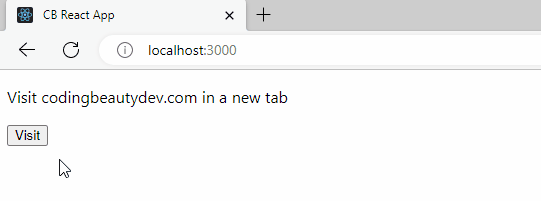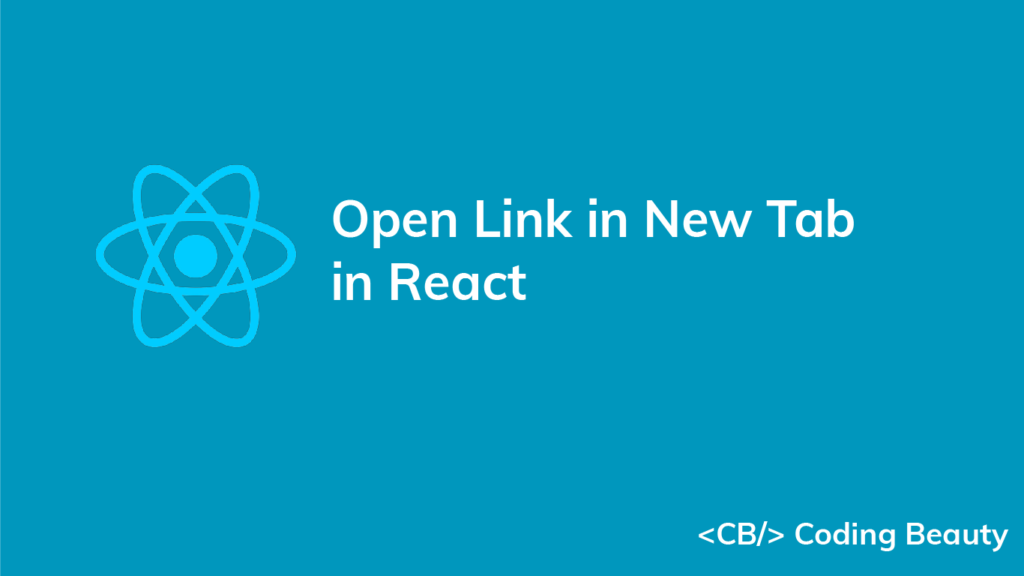To open a link in a new tab in React, create an anchor (<a>) element and set its target attribute to _blank, e.g., <a href="https://codingbeautydev.com" target="_blank">Link</a>. The _blank value specifies that the link should be opened in a new tab.
For example:
App.js
export default function App() {
return (
<div id="app">
<a href="https://codingbeautydev.com" target="_blank" rel="noreferrer">
Coding Beauty
</a>
<br />
<br />
<a
href="https://codingbeautydev.com/blog"
target="_blank"
rel="noreferrer"
>
Coding Beauty Blog
</a>
</div>
);
}
The target property of the anchor element specifies where to open the linked document. By default target has a value of _self, which makes the linked page open in the same frame or tab where it was clicked. To make the page open in a new tab, we set target to _blank.
We also set the rel prop to noreferrer for security purposes. It prevents the opened page from gaining any information about the page that it was opened from.

Open link in new tab programmatically
We can use the window.open() method to programmatically open a link in a new tab in React, e.g., window.open(url, '_blank', 'noreferrer').
For example:
App.js
import { useRef, useEffect, useState } from 'react';
export default function App() {
const [timeLeft, setTimeLeft] = useState(3);
const interval = useRef();
useEffect(() => {
interval.current = setInterval(() => {
// Decrease "timeLeft" by 1 every second
setTimeLeft((prev) => prev - 1);
}, 1000);
return () => clearInterval(interval.current);
}, []);
useEffect(() => {
// Open the link in a new tab when the countdown ends
if (timeLeft === 0) {
clearInterval(interval.current);
// 👇 Open link in new tab programmatically
window.open('https://codingbeautydev.com', '_blank', 'noreferrer');
}
}, [timeLeft]);
return (
<div>
The link will open in <b>{timeLeft}</b> second(s)
</div>
);
}

We use the open() method of the window object to programmatically open a link in a new tab. This method has three optional parameters:
url: The URL of the page to open in a new tab.target: like thetargetattribute of the<a>element, this parameter’s value specifies where to open the linked document, i.e., the browsing context. It accepts all the values thetargetattribute of the<a>element accepts.windowFeatures: A comma-separated list of feature options for the window.noreferreris one of these options.
Passing _blank to the target parameter makes the link get opened in a new tab.
Open link in new tab on button click
Being able to open a link in a new tab programmatically means that we can use a button in place of an anchor link to open a URL on click. We’ll just set an onClick event listener on the button element and call the window.open() method in the listener.
For example:
App.js
export default function App() {
const openInNewTab = (url) => {
window.open(url, '_blank', 'noreferrer');
};
return (
<div>
<p>Visit codingbeautydev.com in a new tab</p>
<button
role="link"
onClick={() => openInNewTab('https://codingbeautydev.com')}
>
Visit
</button>
</div>
);
}

11 Amazing New JavaScript Features in ES13
This guide will bring you up to speed with all the latest features added in ECMAScript 13. These powerful new features will modernize your JavaScript with shorter and more expressive code.

